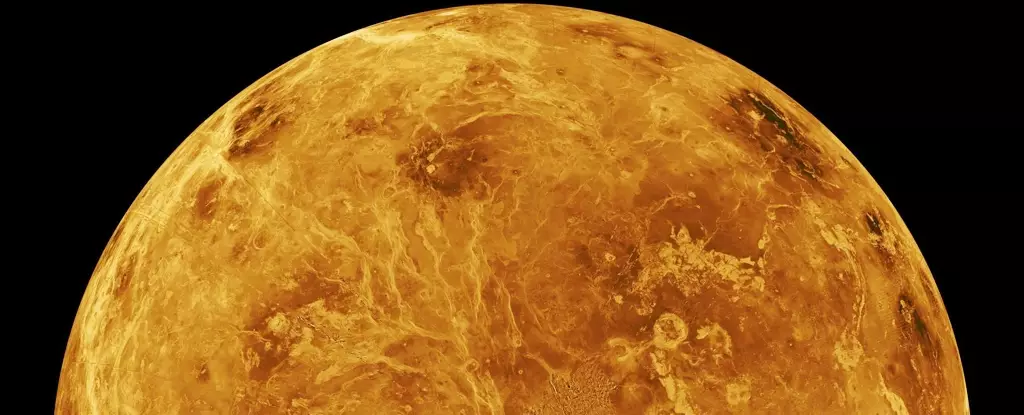In the primordial chaos of the Solar System, violent collisions among celestial bodies were the norm rather than the exception. These early impacts significantly shaped the development of the rocky planets we observe today. As fragments of debris flew through space, they collided with nascent planets like Earth, Mercury, Mars, and the Moon, leaving behind a landscape marred by craters and impact basins. Among these planets, Venus presents a unique paradox: while it showcases a remarkable number of preserved craters, it seemingly lacks larger impact basins, and this peculiar absence has puzzled scientists for decades. The focus of our exploration is the newly discovered evidence surrounding a geologic feature on Venus known as the Haastte-Baad Tessera, poised to deepen our understanding of the planet’s tumultuous past.
What sets Venus apart is not just its captivating beauty, but also its surface that remains, uniquely, a testament to the violence that formed it. Traditionally, scientists have expected to find colossal impact basins similar to those on other rocky planets, given Venus’s formative conditions. Instead, Venus lacks craters larger than 300 kilometers, leading to questions about its geological history and the processes at play during its formative years. The Haastte-Baad Tessera challenges these preconceptions. Recent studies have revealed a series of concentric rings spanning an impressive 1,500 kilometers, and researchers are beginning to suspect that this structure may indeed be the result of two significant impact events that occurred around 3.5 billion years ago.
Geologist Vicki Hansen and her colleagues have put forth compelling analyses suggesting that the Haastte-Baad Tessera is not a mere surface anomaly but a distinctive impact structure. This revelation could provide crucial insights into the early processes that shaped Venus, unlocking secrets of planetary formation that have remained obscured. The tessera’s unique concentric pattern may indicate that two substantial impactors struck the planet in quick succession, forcing their way through a thin crust and into a molten mantle. This hypothesis marks a significant departure from previous beliefs; exploring these intricate formations could yield new understandings of how Venus evolved in an environment where geological activity was markedly different.
The geological mechanisms behind the formation of Haastte-Baad Tessera are tied to speculative models that reveal a dynamic interplay between impacts and the planet’s lithosphere. Hansen posits that the early planetary interior was much hotter and partially molten, allowing impacts to create conditions under which magma surged to the surface. This process results in the surrounding surface deformation seen in the tessera terrain. A comparative study with other celestial bodies, such as Jupiter’s moon Callisto and its massive Valhalla structure, highlights the potential parallels in impact geology. However, unlike these structures, the tessera on Venus lacks the plateau characteristic often found in impact sites, inviting a broader look into planetary formations beyond the impacts themselves.
Diving deeper into the shaping of Haastte-Baad’s landscape, the concept of residuum emerges as a critical factor. As molten magma rises, it can leave behind solid residues, which exhibit unique properties: while stronger than the surrounding mantle, they also possess lower density, resulting in heightened buoyancy. This occurrence can create geological formations that defy typical expectations; what we might assume to be traditional impact craters could, in fact, represent elevated ground formed by buoyant forces at play. Hansen’s work emphasizes that recent understandings of how solid residuum behaves in the early mantle could reshape our interpretations of Venusian geology.
The observations of Haastte-Baad Tessera compel a reconsideration of long-standing assumptions about planetary impacts. The distinctive flat, low-lying structure of tessera terrain leads Hansen to note that scientists have historically looked for conventional depressions when seeking impact craters on Venus. Yet these findings indicate that a more adaptable model is necessary, particularly for Venus, which lacks the thick lithosphere seen on Mars or the Moon. Studying geological features on Earth, such as the dike swarm around Lake Victoria, could further illuminate how analogous processes might manifest across different planetary environments.
The journey to unravel the geological history of Venus has only just begun. The discovery of the Haastte-Baad Tessera as a potential result of twin impacts signifies a breakthrough that could fundamentally reshape our understanding of the planet’s evolution. By continuing to investigate and question long-held beliefs, scientists stand to not only deepen our knowledge of Venus but also the broader processes that govern planetary formation in our Solar System. As more data comes to light, the distinct landscape of Venus may offer clues not just about its past, but about the dynamic interplay of forces that shape all rocky planets.

